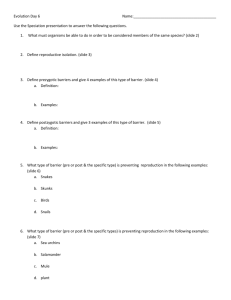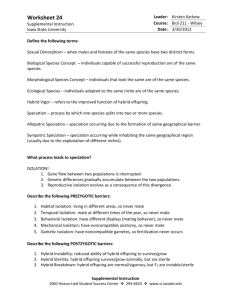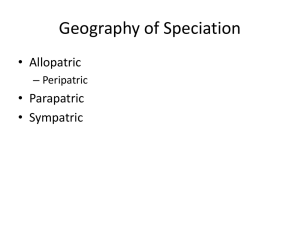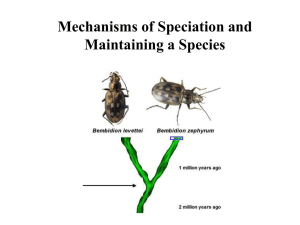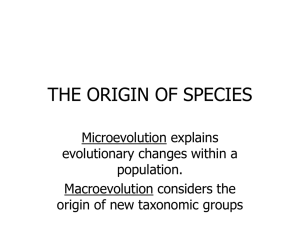Chapter 24 notes
advertisement
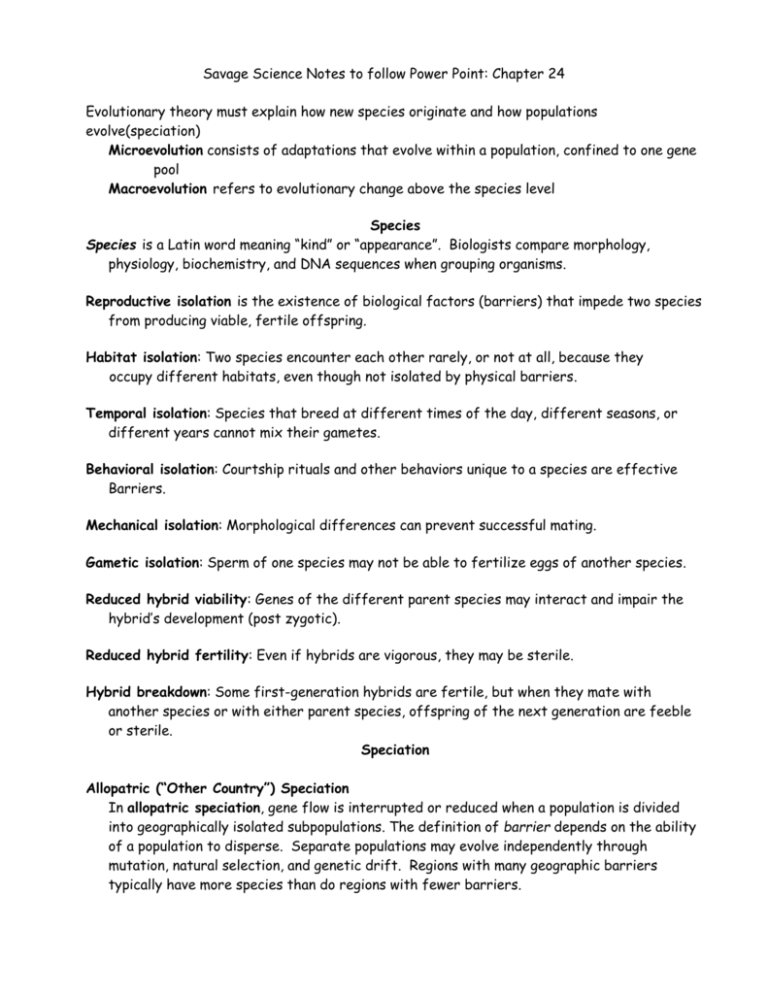
Savage Science Notes to follow Power Point: Chapter 24 Evolutionary theory must explain how new species originate and how populations evolve(speciation) Microevolution consists of adaptations that evolve within a population, confined to one gene pool Macroevolution refers to evolutionary change above the species level Species Species is a Latin word meaning “kind” or “appearance”. Biologists compare morphology, physiology, biochemistry, and DNA sequences when grouping organisms. Reproductive isolation is the existence of biological factors (barriers) that impede two species from producing viable, fertile offspring. Habitat isolation: Two species encounter each other rarely, or not at all, because they occupy different habitats, even though not isolated by physical barriers. Temporal isolation: Species that breed at different times of the day, different seasons, or different years cannot mix their gametes. Behavioral isolation: Courtship rituals and other behaviors unique to a species are effective Barriers. Mechanical isolation: Morphological differences can prevent successful mating. Gametic isolation: Sperm of one species may not be able to fertilize eggs of another species. Reduced hybrid viability: Genes of the different parent species may interact and impair the hybrid’s development (post zygotic). Reduced hybrid fertility: Even if hybrids are vigorous, they may be sterile. Hybrid breakdown: Some first-generation hybrids are fertile, but when they mate with another species or with either parent species, offspring of the next generation are feeble or sterile. Speciation Allopatric (“Other Country”) Speciation In allopatric speciation, gene flow is interrupted or reduced when a population is divided into geographically isolated subpopulations. The definition of barrier depends on the ability of a population to disperse. Separate populations may evolve independently through mutation, natural selection, and genetic drift. Regions with many geographic barriers typically have more species than do regions with fewer barriers. Sympatric (“Same Country”) Speciation In sympatric speciation, speciation takes place in geographically overlapping populations Polyploidy Polyploidy is the presence of extra sets of chromosomes due to accidents during cell division An autopolyploid is an individual with more than two chromosome sets, derived from one species An allopolyploid is a species with multiple sets of chromosomes derived from different species. Much more common in plants than animals. Many important crops (oats, cotton, potatoes, tobacco, and wheat) are polyploids Habitat Differentiation Sympatric speciation can also result from the appearance of new ecological niches For example, the North American maggot fly can live on native hawthorn trees as well as more recently introduced apple trees Sexual Selection Sexual selection can drive sympatric speciation Sexual selection for mates of different colors has likely contributed to the speciation in cichlid fish in Lake Victoria Hybrid zone A hybrid zone is a region in which members of different species mate and produce hybrids. A hybrid zone can occur in a single band where adjacent species meet. Hybrids often have reduced fitness compared with parent species. The distribution of hybrid zones can be more complex if parent species are found in multiple habitats within the same region. When closely related species meet in a hybrid zone, there are three possible outcomes: Strengthening of reproductive barriers Weakening of reproductive barriers Continued formation of hybrid individuals Fusion: If hybrids are as fit as parents, there can be substantial gene flow between species If gene flow is great enough, the parent species can fuse into a single species Patterns in the Fossil Record The fossil record includes examples of species that appear suddenly, persist essentially unchanged for some time, and then apparently disappear. Niles Eldredge and Stephen Jay Gould coined the term punctuated equilibrium to describe periods of apparent stasis punctuated by sudden change. Speciation Rates The punctuated pattern in the fossil record and evidence from lab studies suggests that speciation can be rapid. The interval between speciation events can range from 4,000 years (some cichlids) to 40,000,000 years (some beetles), with an average of 6,500,000 years.

